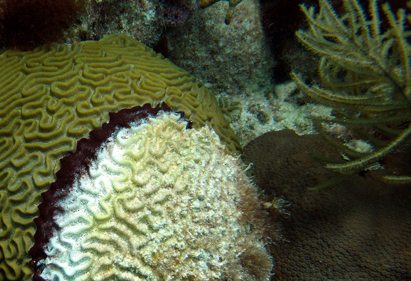No saltwater aquarium is truly complete without a colorful collection of coral. But before you add corals to your aquarium, understand coral can be fickle. It only thrives in just the right temperature and salinity. Stressful conditions make it easy for disease to take over.
Is your coral healthy? The following guide will help you find out:
Common Coral Diseases
Coral Bleaching
What makes coral look so pretty isn’t actually coral, but rather symbiotic organisms that live inside coral tissue called zooxanthellae. They give coral its color.
If your aquarium environment isn’t calibrated correctly, your coral may not be able to support zooxanthellae. Losing zooxanthellae turns tissue transparent, revealing the white exoskeleton underneath. That’s why this disease is called “bleaching”.
The problem is more than aesthetic. Zooxanthellae, unlike coral, is capable of photosynthesis. Coral gets over 90% of its energy from zooxanthellae. Bleaching slows growth, and it eventually leads to tissue loss.
High levels of turbidity can cause coral bleaching. Keep your water clean and clear to prevent this disease.
Black Band Coral Disease
Black band disease is easy to spot – look for a black ring of bacteria spreading throughout the coral. These bacteria (primarily Phormidium corallyticum) create a sulfide-rich environment that kills tissue and exposes exoskeleton.
The band is usually between 1 mm to 5 cm in thickness, and it progresses at a rate of 1 mm to 1 cm per day. It may appear more reddish-brown than black.
Yellow Band Coral Disease
Yellow band disease can be identified by, you guessed it, the distinctive yellow rings it leaves on coral. This disease targets zooxanthellae, leading to the same symptoms as coral bleaching.
Brown Jelly Syndrome
Brown jelly syndrome is characterized by a brown slime spreading over the surface of coral. It also smells rotten, so you can check for this disease by removing coral from your aquarium and taking a whiff.
The cause of brown jelly syndrome is unclear. According to one theory, the jelly substance feeds off dead tissue created by stress or disease instead of destroying tissue itself.
White Band Coral Disease
White band disease is only found on Acropora corals, which are known for their long, antler-like branches. This condition is particularly destructive. In the wild, staghorn coral and elkhorn coral were once quite common. White band disease has left them endangered.
You can identify this disease by the white bands of exposed exoskeleton it leaves behind as it moves up branches. The bands, which can be as thick as 10 cm, generally progress at a rate of 5 mm per day.
The exact cause of white band disease is unknown. Vibrio carchariae is a prime suspect, and zooxanthellae overgrowth is also thought to be a factor.
White Plague Coral Disease
White plague is a lot like white band disease, except that it’s not found on Acropora corals but pretty much looks the same.
White plague can be caused be an Aurantimonas coralicida infection. It’s believed other kinds of bacteria can cause it as well.
As with most coral diseases, the best prevention strategy is to make your aquarium reflect the conditions of your coral’s natural habitat.
related: Coral Bleaching causes and Remedies
Find more information on Coral by viewing our other articles
















